► Aston Vantage vs Porsche 911
► Battle of the £100k sports cars
► Which would you choose?
The difference is obvious from the first corner. Whether you’re comparing old Aston Martin Vantage with new Vantage, or new Vantage with current DB11, it’s clear that this is a seriously focused sports car. There was always a lot of goodwill attached to the Vantage, even though it’s spent a decade being well past its peak; Aston made the most of it and took to marketing its ageing sports car – complete with hydraulic steering, manual gearbox and naturally-aspirated engine – as the old-school darling of the discerning driver.
But that’s all changed, not least because Aston can no longer liberally chuck about the word ‘analogue’ – the all-new Vantage sports an electric rack, an eight-speed ZF auto as the sole transmission option for now, and its own tune of AMG’s twin-turbo 4.0-litre V8. And this new Vantage is the sports car of the moment, and for once not the old-school survivor.
So the comparison that matters most now is not Aston vs Aston, but Aston vs Porsche 911. There’ll be a new 992 iteration on our streets next year replacing this 991-generation 911 that arrived in late 2011, complete with a new chassis and electric power steering. Less than three years ago a substantial facelift ushered in a new twin-turbo 3.0-litre flat-six in place of the larger, naturally-aspirated motors. It’s still the sports car benchmark, but in the new Aston Martin Vantage it faces a deadly serious opponent.
In detail: the new Aston Martin Vantage
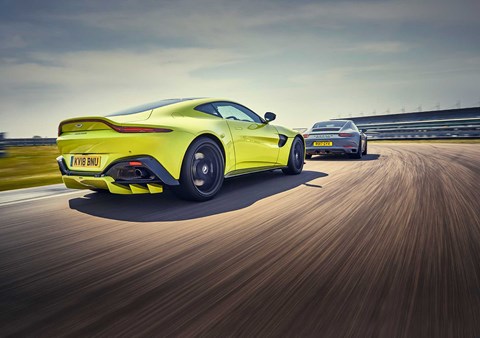
Particularly when Aston is on such a roll. Profits were up £250 million last year; sales were up 58 per cent. Just around the corner there’s a new flagship, the 700bhp DBS Superleggera, followed by the DBX SUV that CEO Andy Palmer insisted had to happen as a condition of him joining the company in 2014. There’s more to come, too. If the FIA gets its act together Aston might enter Formula 1 as an engine supplier to Red Bull, a relationship that’s already yielding the Valkyrie hypercar and that will, in time, deliver a mid-engined Ferrari 488 rival. And we haven’t even mentioned the relaunch of Lagonda as an all-electric luxury brand…
But here and now we’re in a scorchingly hot Rockingham pitlane. In a ferocious shade of acid green, the Vantage looks sensational – the conservative, more organic Porsche all but invisible next to it. Push on the inset door release, swing yourself down into the ultra-low seat and you’re struck simultaneously by the luxury and the potency of the thing. This is truly great sports car cockpit – like a leatherbound GT3 racer.
Pull the lightweight door closed with the stitched leather strap and peer through the square wheel into three clear and crisp digital dials that change their displays as you cycle through the drive modes. Buttons cascade down the dash like the terraced farms at Machu Picchu (if Machu Picchu were underpinned by Mercedes electronic architecture). And it all works. Sounds like basic housekeeping, but this is the stuff that’s normally so hard for companies like Aston. But from now on every new Aston will be up to date, and no longer will customers wonder why their new dream sports car or GT uses a sat-nav inferior to the one in their last hire car.
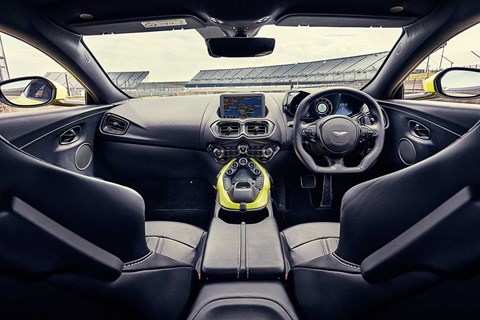
Wake the engine and you’re reminded that the 4.0-litre AMG unit is a truly great sports car engine; as Ben Barry said when he drove the Vantage on its launch, the engine feels ‘always on’. Pull the right shift paddle to engage drive, release the electronic handbrake and the Vantage is off, trundling away without a hint of throttle, impatient to get out on track.
Roll out onto the circuit, wait a polite half a lap to warm the lubricants, and pin it: cue fire and fury, a cacophony of noise and a thick wodge of power, torque and sledgehammer performance to blast away any lingering mid-morning sleepiness. Surprisingly quiet on start-up, the Aston soon goes about making up for lost time. In its motive force and majestic din it is relentless, the sound and physics becoming all-consuming as you get into your stride.
If you’ve recently driven the last Vantage, the new one comes as a plunge-pool shock. Compared to the car that joined us in 2005, the new car has moved the goalposts – not just within the park but out of the gates, down the road and to a different park entirely. The last-of-the-line V8 Vantage AMR sported 430bhp and 361lb ft. The new one, which is barely any heavier, has 503bhp and 505lb ft. If your focus is purely on outputs, the 911 you’ll need to make direct comparisons with this ‘entry-level’ Vantage is the GT3 or 911 Turbo, not today’s 911 Carrera GTS.
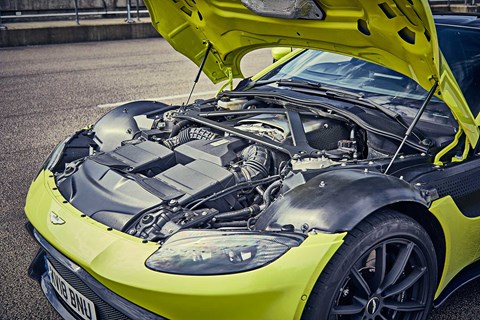
But while the Vantage’s torque has leapt up it doesn’t come flooding in from tickover, ruining the fun like a pushy diesel in the way some boosted performance engines can. Mighty it may be, but the Vantage’s V8 asks that you work it right to its upper reaches whenever you’ve the space, Ferrari style.
The ZF ’box is equally impressive: smooth at low speeds, punchy and quick when you need it and always happy to serve up the next ratio – up or down – when Merc’s own transmission sometimes gets caught out and won’t give you the gear you want. And where the AMG GT – the car from which the Aston nabs the bulk of its engine – sometimes feels like a curious beast, its axles a little out of sync with you in the middle, the Vantage moves the game on.
Aston hasn’t left the AMG 4.0-litre V8 alone. It’s changed the turbos and revised the wet sump to get the lump lower and further back in the chassis: pop the bonnet and you’ll notice the front half of the engine bay contains no engine whatsoever. Tucked right at the bulkhead you’ll find the ‘hot-in-vee’ turbos, and they’re usually hot enough to smelt any sword you might carelessly leave close by.
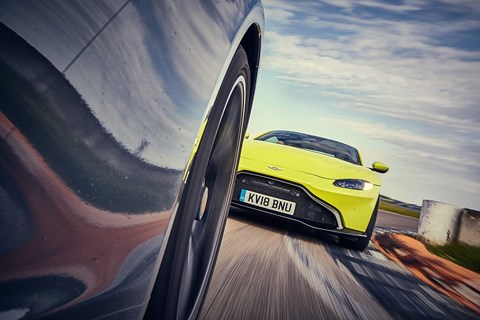
All engine and no trousers? No, not these days. After the DB11, the Vantage is only the second model in Aston’s Second Century Plan – and the pair’s sales success is crucial to the funding of the company’s future. The Vantage is a short DB11: 100mm has been taken out of the wheelbase. While it’s precisely that sort of platform sharing that led to its predecessor and the old DB9 being so similar to drive, Aston’s worked hard to differentiate here.
Enough of the structure is shared to make economic sense, but not so much that the Vantage will be the butt of any more Russian-doll jibes. Only about 30 per cent of the bonded aluminium structure is common; unlike the DB11, the rear subframe is rigidly mounted; and while the double-wishbone front suspension and multi-link rear are carried over, the springs and dampers are tuned specifically for the Vantage’s shorter, lighter platform.
They’ve done a great job. The dampers range through Sport, Sport+ and Track settings, rather than the DB11’s GT, Sport and Sport+, and from the outset the taut, tightly controlled ride is a clear differentiator. The steering too – which isn’t quicker but feels like it is because of the shorter wheelbase – makes the Vantage immediately more responsive to your inputs.
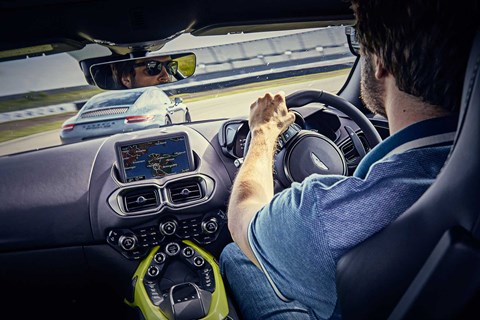
On track you have to take a moment, breathe, and set to with cool purpose and a calm head. Otherwise the engine’s drama and the nose’s rate of response will have you chasing yourself giddy, making mistakes and failing to uncover the Vantage’s real potential.
See past the power and the pomp and it begins to dawn on you just how accomplished the Aston is. That squared-off steering wheel may look gimmicky, but the reality is that you never need to move your hands on the wheel as the steering is so fast. You soon tune into it; the subtle but helpful feedback, the way the nose can reliably run into an apex at speed with a little trailed brake, and the intuitive effortlessness with which you can correct the mild oversteer that comes into play as you relax the stability control.
With a few laps under your belt you get into a fast, exciting and rewarding groove, threading that vast but nimble nose through entry, apex and exit. The engine’s instant response and the impressive traction from Aston’s first e-diff combine to allow giddying speeds as you hammer towards each straight’s brake marker boards. If only the front end was a little easier to place – a visibility issue even more keenly felt on the road. Guiding the Vantage at speed is tricky because you sit so low, the base of the screen is high and the front is wide and without conspicuous wings. On the road, oncoming cars have you panicked; vans have you diving into the passenger footwell.
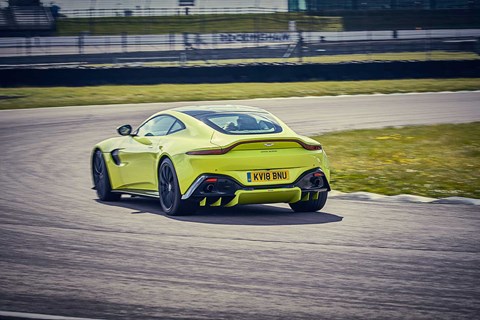
The ride’s impressive, soaking up broken tarmac a sports car has no right to ride over so imperiously, and on wider, better-surfaced roads the Vantage is in its element. In a blur of noise and speed you flash past slower traffic, spear through clear roundabouts with confidence-inspiring composure and decimate all your old cross-country personal bests.
Circuit driving can throw up a curious oscillation when you load the car up laterally, such as in a couple of Rockingham’s long, fast corners. Switch up to the full-blooded Track damper setting and it’s reduced, as the body control gets really locked down, but it never quite disappears. And while the brakes are good they’re not infallible: in traffic the imperfect modulation is almost like a set of stone-cold ceramics, yet you don’t then have the relentless stopping power the Vantage’s sheer pace can make you wish you had.
Climbing back into the Porsche, I’m quite prepared to find we’ve brought along the ‘wrong’ 911: that we’ll need a GT3 to best the Vantage for driver engagement, or a Turbo to top its performance. But we didn’t chose the Carrera GTS lightly. It has an extra 30bhp and 37lb ft on top of the Carrera S, for 444bhp and 406lb ft. The 44mm wider body from the Carrera 4 hides a 26mm wider track, the car sits on 20-inch centre-lock wheels half an inch wider front and rear, and there are active engine mounts, bigger front brakes and pads, plus a sports exhaust and a 20mm lower chassis together with adaptive dampers. It’s all the 911’s best options rolled into one package. Rear-wheel drive and a manual gearbox are standard, and together with £1592 rear-wheel steering and £2273 active anti-roll bars this is optimal 911 unless you’ve begged, stolen or borrowed your way onto the list for a GT3 or GT2.
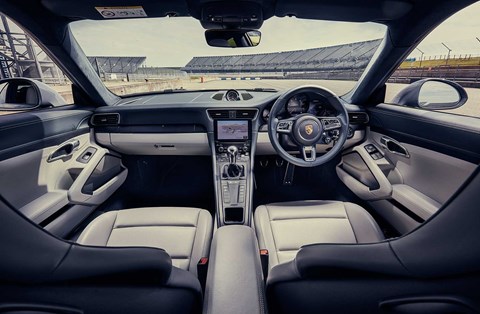
Coming to it after the Aston, you need to make a few mental recalibrations, otherwise you’ll drift into thinking that there’s nothing special about the Porsche. The shape is so familiar, the details so low-key compared to the Vantage, that you don’t stop and stare; you don’t feel compelled to examine and admire it like you will the first time you see the Aston. Next to the Vantage the Porsche looks narrow, its nose too high. Just as we thought Jennifer Lopez was curvy until Kim Kardashian came along, so you won’t give the 911’s hips a second thought once you’ve admired the Aston’s cartoonishly wide rear. From the narrow headlights and enormous front grille to the kicked-up tail and serious-looking diffuser, the new Vantage is a bold departure from the demure Vantages of old.
Inside, the Carrera GTS is similarly low-key. The interior quality took a big leap forward with the 991-gen 911, but as it nears the end of its life it’s missing both the bold modernity of the Aston and the tech found in the Panamera and Cayenne (though personally I much prefer a button-festooned cabin). This particular car has been specced in a particularly sombre manner: the standard alcantara seats and steering wheel have been replaced with the no-cost option of leather, and the rear-seat delete option hasn’t been ticked. The 997-generation GTS had an edgy skunkworks feel, but the GTS badge has more recently been strewn liberally across all sorts of Porsches, robbing this car of a little of its specialness.
That’s initially true of the driving experience as well. If your reference point is a naturally-aspirated 911 of the past decade, you’ll quickly decide that this turbocharged engine doesn’t have the same instant response or howl. Neither does the electric steering brim with feel like the 997 GTS’s hydraulic rack did. And you don’t need a 911R or a new manual GT3 to show up the seven-speed gearbox; the six-speeder in a Boxster or Cayman is both tighter across the gate and slots home more sweetly.
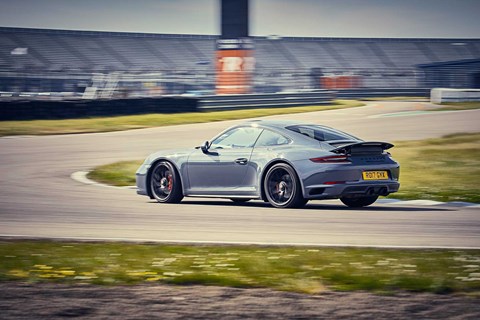
But hold on. Just because 911s of old, or the rare-groove models higher up the range, may offer greater thrills, that doesn’t mean this Carrera GTS isn’t a dynamic threat to the Aston. But in fact it’s with some very fundamental basics that the Porsche lands its first blows. Rivals spend millions developing high-tech diffs, e-boosted engines and multi-stage slide control, only for the world to decide that actually it prefers the familiar excellence of a 911’s seats, driving position, enormous windscreen and excellent over-the-shoulder visibility – the boring stuff – not to mention how intuitive and solidly built all the controls feel.
Day to day you revel in the 911’s usability, its boot space and its back seats, plus the convenience of being able to park it anywhere. It all feeds into an immediate confidence, whether you’re leaving it parked on the street overnight or heading out onto an unfamiliar racetrack for the first time.
As on the road, you feel instantly part of everything: driving a 911 GTS on track is an intimate experience shared between you and the car. The weighting of the steering is more consistent than the Aston’s, those first few fractions of a turn spot-on where the Vantage’s new electric system is light and then heavy. The whole car is lighter, more lithe and more nuanced than the Aston, its responses sharper and more consistently faithful. The gearbox isn’t Porsche’s best but it’s sweet nonetheless, and you’ll never get tired of that moment when you’re working the superb brake pedal and blipping the throttle from sixth to fifth… or third.
On track, even without trying, you can play with the weight transfer, or set everything to Sport+, keep it tidy and really feel the benefit of the wider rear track, active engine mounts, active anti-roll system and rear-wheel steering. Now the rear locks in tight, the 911’s laden rear axle letting you chase the throttle earlier and earlier, the traction beggaring belief. The Porsche’s almost push-free front end also highlights the Aston’s fractionally greater tendency to understeer. With some effort the flat-six – even water-cooled and turbo-boosted as it is – begins to shine. Push past the thick mid-range torque and there’s a high-rev rush very nearly as hard-hitting and as intoxicating as the Aston’s.
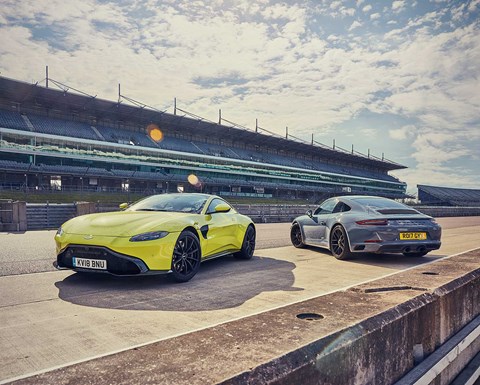
Dynamically, the Aston does not come up short. Not a bit of it. But neither does it steal a lead. In isolation the Aston is awesome, a full-on driving machine of compelling talent and ferocity. But the 911 is, its own way, equally thrilling – incessant evolution doesn’t make for a paucity of emotion. The Aston is more dramatic but it’s also comfortable, nowhere near as loud as you’d imagine given the brash styling and entirely plausible as a very special daily driver, without compromising its colossal feelgood factor.
So, there is no winner. Disappointing if you were expecting the plucky British newcomer to wipe the floor with the German benchmark. But getting so close to such a brilliant car is a strong result, and proof that Aston’s new dawn is built on some seriously good cars. A score draw against the Porsche 911? That’s as good as it gets.
Aston Martin Vantage specs
Price £120,900 (£141,915 as tested)
Engine 3982cc 32v twin-turbo V8, 503bhp @ 6500rpm, 505lb ft @ 2000rpm
Transmission 8-speed auto, rear-wheel drive
Suspension Double-wishbone front, multi-link rear
Performance 3.6sec 0-62mph, 195mph, 26.8mpg, 245g/km CO2
Weight 1630kg
On sale Now
Rating ★★★★★
Porsche 911 Carrera GTS specs
Price £95,795 (£107,359 as tested)
Engine 2981cc 24v twin-turbo flat-six, 444bhp @ 6500rpm, 406lb ft @ 2150rpm
Transmission 7-speed manual, rear-wheel drive
Suspension MacPherson strut front, multi-link rear
Performance 4.1sec 0-62mph, 193mph, 30.1mpg, 212g/km CO2
Weight 1450kg
On sale Now
Rating ★★★★★
Check out more of CAR magazine’s comparison test reviews